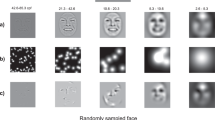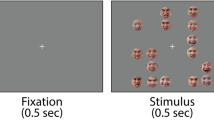Abstract
The current study examined whether social anxiety is associated with a biased perception of the overall emotional impression of facial crowds. Participants were presented with facial crowds that consisted of 6, 12, or 24 faces expressing either happiness or anger, after which they were asked to judge whether the crowds were positive or negative. We estimated each participant’s point of subjective equality (PSE) and precision when judging the overall emotion of facial crowds to be negative. The participants’ social anxiety levels were negatively associated with their PSEs to perceive the overall emotion of the crowds as negative. In contrast, there was no significant relation between social anxiety and the degree of precision in the participants’ judgments of facial crowds. These findings indicate that socially anxious individuals lack the positive biases that are present in non-anxious individuals and, thereby, perceive the overall emotion of crowds more negatively compared with their less anxious counterparts.

Similar content being viewed by others
References
Alloy, L. B., & Abramson, L. Y. (1988). Depressive realism: Four theoretical perspectives. In L. B. Alloy (Ed.), Cognitive processes in depression (pp. 223–265). New York: Guilford Press.
American Psychiatric Association. (2000). Diagnostic and statistical manual for mental disorders (4th ed.TR). Washington, DC: Author.
Amir, N., & Taylor, C. T. (2012). Interpretation training in individuals with generalized social anxiety disorder: A randomized controlled trial. Journal of Consulting and Clinical Psychology, 80, 497–511.
Brainard, D. H. (1997). The psychophysics toolbox. Spatial Vision, 10, 433–436.
Carson, R. C., Hollon, S. D., & Shelton, R. C. (2010). Depressive realism and clinical depression. Behaviour Research and Therapy, 48, 257–265.
Chong, S. C., & Treisman, A. (2003). Representation of statistical properties. Vision Research, 43, 393–404.
Chong, S. C., & Treisman, A. (2005). Statistical processing: Computing the average size in perceptual groups. Vision Research, 45, 891–900.
Chung, Y., & Kwon, J.-H. (2006). Effects of feedback type on social interaction of individuals with social phobia. Korean Journal of Clinical Psychology, 25, 489–504.
De Jong, P. J. (2002). Implicit self-esteem and social anxiety: Differential self-favouring effects in high and low anxious individuals. Behaviour Research and Therapy, 40, 501–508.
Fay, N., Page, A. C., Serfaty, C., Tai, V., & Winkler, C. (2008). Speaker overestimation of a communication effectiveness and fear of negative evaluation: Being realistic is unrealistic. Psychonomic Bulletin & Review, 15, 1160–1165.
Fu, T. S. -T., Koutstaal, W., Poon, L., & Cleare, A. J. (2012). Confidence judgment in depression and dysphoria: The depressive realism vs. negativity hypotheses. Journal of Behavior Therapy, 34, 699–704.
Gilboa-Schechtman, E., Presburger, G., Marom, S., & Hermesh, H. (2005). The effects of social anxiety and depression on the evaluation of facial crowds. Behaviour Research and Therapy, 43, 467–474.
Haberman, J., & Whitney, D. (2007). Rapid extraction of mean emotion and gender from sets of faces. Current Biology, 17, R751–R753.
Haberman, J., & Whitney, D. (2009). Seeing the mean: Ensemble coding for sets of faces. Journal of Experimental Psychology: Human Perception and Performance, 35, 718–734.
Hallion, L. S., & Ruscio, A. M. (2011). A meta-analysis of the effect of cognitive bias modification on anxiety and depression. Psychological Bulletin, 137, 940–958.
Heinrichs, N., & Hofmann, S. G. (2001). Information processing in social phobia: A critical review. Clinical Psychology Review, 21, 751–770.
Hertel, P. T., & Mathews, A. (2011). Cognitive bias modification: Past perspectives, current findings, and future applications. Perspectives on Psychological Science, 6, 521–536.
Hirsch, C. R., & Clark, D. M. (2004). Information-processing bias in social phobia. Clinical Psychology Review, 24, 799–825.
Hirsch, C. R., & Mathews, A. (2000). Impaired positive inferential bias in social phobia. Journal of Abnormal Psychology, 109, 705–712.
Hofmann, S. G. (2007). Cognitive factors that maintain social anxiety disorder: A comprehensive model and its treatment implications. Cognitive Behaviour Therapy, 36, 195–209.
Johnson, D. D., & Fowler, J. H. (2011). The evolution of overconfidence. Nature, 477, 317–320.
Kim, H. S. (2001). Memory bias in subtypes of social phobia. Unpublished master dissertation, Seoul National University, Seoul, Korea.
Kistner, J., Balthazor, M., Risi, S., & David, C. (2001). Adolescents’ perceptions of peer acceptance: Is dysphoria associated with greater realism? Journal of Social and Clinical Psychology, 20, 66–81.
Lange, W.-G., Keijsers, G., Becker, E. S., & Rinck, M. (2008). Social anxiety and evaluation of social crowds: Explicit and implicit measures. Behaviour Research and Therapy, 46, 932–943.
Lange, W.-G., Heuer, K., Langner, O., Keijsers, G. P. J., Becker, E. S., & Rinck, M. (2011). Face value: Eye movements and the evaluation of facial crowds in social anxiety. Journal of Behavior Therapy and Experimental Psychiatry, 42, 355–363.
Lee, T. H., Lee, K. Y., Lee, K., Choi, J. S., & Kim, H. T. (2006). The Korea University facial expression collection: KUFEC. Lab of Behavioral Neuroscience. Department of Psychology, Korea University, Seoul, Korea.
Mathews, A., & MacLeod, C. (1994). Cognitive approaches to emotion and emotional disorders. Annual Review of Psychology, 45, 25–50.
Mattick, R. P., & Clarke, J. C. (1998). Development and validation of measures of social phobia scrutiny fear and social interaction anxiety. Behaviour Research and Therapy, 36, 455–470.
Mayfrank, L., Kimmig, H., & Fischer, B. (1987). The role of attention in the preparation of visually guided saccadic eye movements in man. In J. K. O’Regan & A. Levy-Schoen (Eds.), Eye movements: From physiology to cognition (pp. 37–45). New York, NY: North-Holland.
Pelli, D. G. (1997). The videotoolbox software for visual psychophysics: Transforming numbers into moves. Spatial Vision, 10, 437–442.
Peters, L. (2000). Discriminant validity of the Social Phobia and Anxiety Inventory (SPAI) and the Social Phobia Scale (SPS) and the Social Interaction Anxiety Scale (SIAS). Behaviour Research and Therapy, 38, 943–950.
Pinto-Gouveia, J., Cunha, M. I., & Salvador, M. C. (2003). Assessment of social phobia by self-report questionnaires: The Social Interaction and Performance Anxiety and Avoidance Scale and the Social Phobia Safety Behaviours Scale. Behavioural and Cognitive Psychotherapy, 31, 291–311.
Taylor, S. E., & Brown, J. D. (1988). Illusion and well-being: A social psychological perspective on mental health. Psychological Bulletin, 103, 193–210.
Wichmann, F. A., & Hill, N. J. (2001a). The psychometric function: I. Fitting, sampling, and goodness of fit. Perception & Psychophysics, 63, 1293–1313.
Wichmann, F. A., & Hill, N. J. (2001b). The psychometric function: II. Bootstrap-based confidence intervals and sampling. Perception & Psychophysics, 63, 1314–1329.
Yoon, K. L., & Zinbarg, R. E. (2007). Threat is in the eye of the beholder: Social anxiety and the interpretation of neutral facial expressions. Behaviour Research and Therapy, 45, 839–847.
Yoon, K. L., & Zinbarg, R. E. (2008). Interpreting neutral faces as threatening: A default mode for social anxiety. Journal of Abnormal Psychology, 117, 680–685.
Acknowledgments
This research was supported in part by the ADVANCE Rising Tide Center with funding from NSF, Grant #1008498 to KLY and the Yonsei University Research Fund of 2010 to SCC.
Conflict of interest
We declare that we have no conflict of interest.
Author information
Authors and Affiliations
Corresponding authors
Additional information
Jae-Won Yang and Lira Yoon contributed equally to this work, and the co-first authors are listed in alphabetical order.
Rights and permissions
About this article
Cite this article
Yang, JW., Yoon, K.L., Chong, S.C. et al. Accurate but Pathological: Social Anxiety and Ensemble Coding of Emotion. Cogn Ther Res 37, 572–578 (2013). https://doi.org/10.1007/s10608-012-9500-5
Published:
Issue Date:
DOI: https://doi.org/10.1007/s10608-012-9500-5




